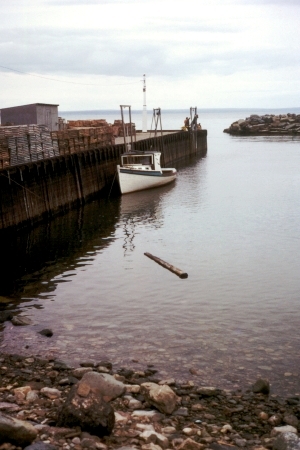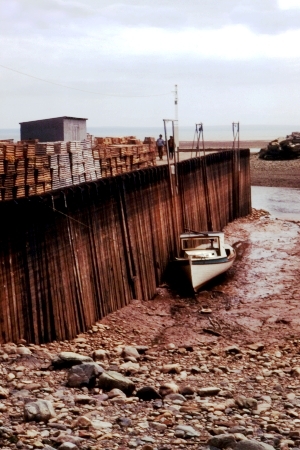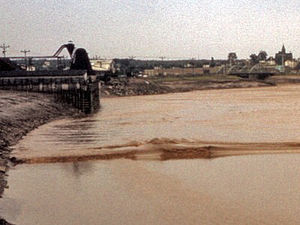Bay of Fundy
The Bay of Fundy (French: Baie de Fundy) is a bay located on the Atlantic coast of North America, on the northeast end of the Gulf of Maine between the Canadian provinces of New Brunswick and Nova Scotia, with a small portion touching the U.S. state of Maine. The Bay of Fundy is known for having the greatest difference in water level between its high and low tides in the world. The name "Fundy" is thought to date back to the 16th century when the Portuguese referred to the bay as "Rio Fundo" or "deep river". The bay contains about 100 million cubic meters of water.
The bay was also named Baie François by explorer/cartographer Samuel de Champlain during a 1604 expedition led by Pierre Dugua, Sieur de Monts which resulted in a failed settlement attempt on St. Croix Island.
Contents |
Tides
Folklore in the Mi'kmaq First Nation claims that the tides in the Bay of Fundy are caused by a giant whale splashing in the water. Oceanographers attribute it to tidal resonance resulting from a coincidence of timing: the time it takes a large wave to go from the mouth of the bay to the opposite end and back is the same as the time from one high tide to the next. In other words, the 12.4 hour period of the lunar tides is close to the natural sloshing period of the bay, so the moon sloshes it as if it were a bathtub.
The quest for world tidal dominance has also led to a pseudo-rivalry between the Minas Basin in the Bay of Fundy and the Leaf Basin in Ungava Bay over which water body lays claim to the highest tides in the world, with supporters in each region claiming the record.
The Canadian Hydrographic Service finally declared it a statistical tie, with measurements of a 16.8 metre tidal range in Leaf Basin for Ungava Bay and 17 metres at Burntcoat Head, Nova Scotia for the Bay of Fundy.[1] The highest water level ever recorded in the Bay of Fundy system occurred at the head of the Minas Basin on the night of October 4–5, 1869 during a tropical cyclone named the “Saxby Gale”. The water level of 21.6 metres resulted from the combination of high winds, abnormally low atmospheric pressure, and a spring tide.
Leaf Basin has only been measured in recent years, whereas the Fundy system has been measured for many decades. Tidal experts note that Leaf Basin is consistently higher on average tides than Minas Basin, however the highest recorded tidal ranges ever measured are at Burntcoat Head, and result from spring tides measured at the peak of the tidal cycle every 18 years.
Tidal electrical power generation
Several proposals to build tidal harnesses for electrical power generation have been put forward in recent decades. Such proposals have mainly involved building barrages which effectively dam off a smaller arm of the bay and extract power from water flowing through them.
One such facility exists, the Annapolis Royal Generating Station consists of a dam and 18-MW power house on the Annapolis River at Annapolis Royal, Nova Scotia, but larger proposals have been held back by a number of factors, including environmental concerns. The Annapolis Royal Generating Station has been studied for its various effects, including an accelerated shoreline erosion problem on the historic waterfront of the town of Annapolis Royal, as well as increased siltation and heavy metal and pesticide contamination upstream due to lack of regular river/tidal flushing. There have also been instances where large marine mammals such as whales have become trapped in the head pond after transiting the sluice gates during slack tide.
Damming a large arm of the Bay of Fundy would have significant and not well-understood effects both within the dammed bay itself and in the surrounding regions. Intertidal habitats would be drastically affected and a facility would bring the bay closer to resonance, increasing tidal range over a very large area. One effect could be an increase in tidal range of 0.2 m (from approximately 1 m) for certain coastal sites in Maine, possibly leading to flooding.
There have been proposals in recent years for installing aquanators, the underwater equivalent to wind turbines, which would not require any damming or blockading of parts of the bay but would instead generate electricity solely by being placed in areas of high water flow, such as at choke points or merely along the floor of any part of the bay which sees significant water movement.
Geography
Sub-basins
The upper part of the bay bifurcates, splitting into Chignecto Bay in the northeast and the Minas Basin in the east. Chignecto Bay is further subdivided into Cumberland Basin and Shepody Bay and the extreme eastern portion of Minas Basin is called Cobequid Bay. Some of these upper reaches exhibit exposed red bay muds, for which the Bay of Fundy is noted (for their appearance and biological productivity).
Cape Chignecto Nova Scotia defines Chignecto Bay whereas Cape Split, Nova Scotia defines the Minas Channel, leading to the Minas Basin.
The lower part of the bay is also home to four important sub-basins: Passamaquoddy Bay and Back Bay on the New Brunswick shore, Cobscook Bay on the Maine shore, and the Annapolis Basin on the Nova Scotia shore.
The bay is home to several islands, the largest of which is Grand Manan Island at the boundary with the Gulf of Maine. Other important islands on the north side of the bay include Campobello Island, Moose Island, and Deer Island in the Passamaquoddy Bay area. Brier Island and Long Island can be found on the south side of the bay while Isle Haut is located in the upper bay off Cape Chignecto. Smaller islands and islets also exist in Passamaquoddy Bay, Back Bay, and Annapolis Basin. The Five Islands, in the Minas Basin, are particularly scenic.
Rivers
The bay receives the waters of several rivers, including:
New Brunswick
- Magaguadavic River
- Memramcook River
- Petitcodiac River
- Saint John River
- St. Croix River
- Shepody River
- Tantramar River
Nova Scotia
The bay's extreme tidal range causes several interesting phenomena in the various rivers which empty into it.
The Saint John River sees its flow reversed at high tide, causing a series of rapids at the famous Reversing Falls where the river empties into the bay, located in a gorge in the middle of the city of Saint John.
Rivers in the upper Bay of Fundy have a smaller flow-rate than the Saint John, and a shallower slope. As a result, extensive mud flats are deposited throughout the tidal range of the rivers.
Another phenomenon which occurs in these rivers of the upper bay is a "tidal bore", whereby the river flow is completely reversed by the rising tide. One of the better examples of a tidal bore can be seen on the Shubenacadie River near the town of Truro and the village of Maitland, where local ecotourism operators offer the chance to experience rafting the bore upriver. Another good example of a tidal bore may be viewed on the Salmon River in the town of Truro. The once-famous tidal bores on the Petitcodiac and Avon rivers have been severely disrupted as a result of causeway construction in the 1960s-1970s which have caused excessive siltation.
Communities
The largest population centres on the bay are the New Brunswick cities of Saint John and Moncton.
The New Brunswick towns of St. Andrews, Blacks Harbour, and Sackville as well as the Nova Scotia towns of Amherst, Parrsboro, Truro, Windsor, Wolfville, Annapolis Royal, and Digby are also located on the bay.
Ports and shipping
The port of Saint John is access to the pulp and paper industry and the Irving oil refinery. Hantsport, Nova Scotia on the Avon River is also home to a pulp and paper mill and is the shipment point for raw gypsum exports to the United States. The ports of Bayside, New Brunswick (near St. Andrews) and Eastport, Maine are important local ports.
A result of shipping traffic has been the potential for increased collisions between ships and the North Atlantic Right Whale. In 2003, the Canadian Coast Guard adjusted shipping lanes crossing prime whale feeding areas at the entrance to the Bay of Fundy to lessen the risk of collision.
The bay is also traversed by several passenger and automobile ferry services:
- Saint John, New Brunswick to Digby, Nova Scotia (operated by Bay Ferries Limited)
- Grand Manan Island to Blacks Harbour, New Brunswick and White Head Island to Grand Manan Island (operated by Coastal Transport Limited)
- Deer Island to Letete, New Brunswick (operated by New Brunswick Department of Transportation)
- Campobello Island to Deer Island and Eastport, Maine to Deer Island (operated by East Coast Ferries Limited)
- Westport, Nova Scotia (Brier Island) to Freeport, Nova Scotia (Long Island) and Tiverton, Nova Scotia (Long Island) to East Ferry, Nova Scotia (operated by Nova Scotia Department of Transportation and Public Works)



